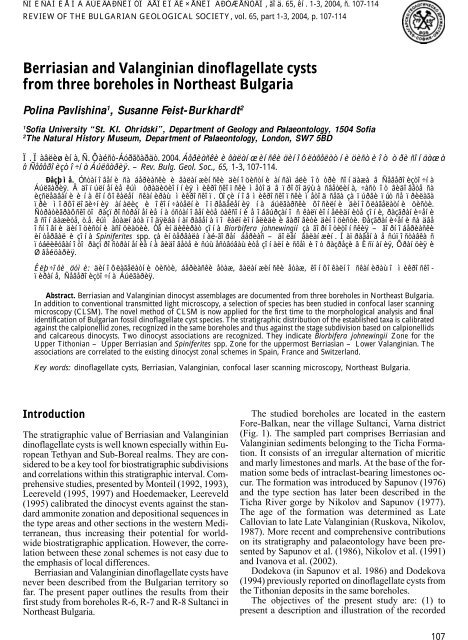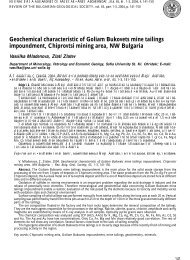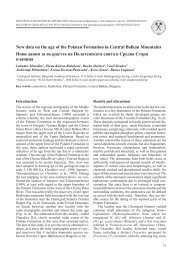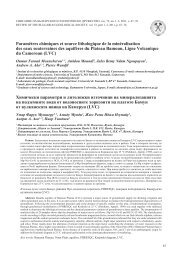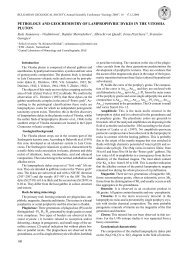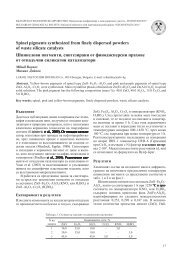Berriasian and Valanginian dinoflagellate cysts from three ...
Berriasian and Valanginian dinoflagellate cysts from three ...
Berriasian and Valanginian dinoflagellate cysts from three ...
- No tags were found...
You also want an ePaper? Increase the reach of your titles
YUMPU automatically turns print PDFs into web optimized ePapers that Google loves.
Fig. 1. Location map <strong>and</strong> lithostratigraphic column of the studied boreholes. Sample positions are indicated to the right of thecolumnsÔèã. 1. Ãåîãðàôñêî ïîëîæåíèå è ëèòîñòðàòèãðàôèÿ íà èçñëåäâàíèòå ñîíäàæè. Ìåñòàòà íà ïðîáèòå ñà îçíà÷åíè îòäÿñíîíà êîëîíêèòå108
109dinocyst assemblages; (2) to assess the age <strong>and</strong> correlatethe succession to the biostratigraphically well controlledframework established for the western Tethyanrealm; (3) to provide a direct calibration of the dinocystassociations to the calpionellid <strong>and</strong> calcareous dino<strong>cysts</strong>uccessions <strong>and</strong> zones, recognized in the same boreholes.Material <strong>and</strong> methodsThe present study is based on eleven core samples,containing relatively rich <strong>and</strong> well-preserved <strong>dinoflagellate</strong>cyst assemblages. The position of the samples isindicated in Fig. 1. They were collected <strong>from</strong> the marlylimestones in the sampled interval.The samples were prepared for palynological analysisfollowing st<strong>and</strong>ard preparation techniques, includingHCl, HF treatment <strong>and</strong> separation with heavy liquid.Strew mounts were prepared in Elvacit, a commercialmounting medium on the basis of resin. The slides containingthe illustrated specimens are stored in the collectionsof the Geological Institute, Bulgarian Academyof Sciences.The morphological analysis of the species is primarilybased on the results in transmitted light microscopy,since this is the main tool used in routine palynologicalstudies. Photomicrographs in transmitted light havebeen taken using Differential Interference contrast(DIC) on a BH2 Olympus microscope at the NaturalHistory Museum, London.In addition to conventional transmitted light microscopy,a selection of species has been studied in confocallaser scanning microscopy. Only recently, CLSMhas been successfully applied for the first time to themorphological analysis of fossil <strong>dinoflagellate</strong> <strong>cysts</strong> byFeist-Burkhardt, Pross (1999) <strong>and</strong> Feist-Burkhardt,Monteil (2001).The novel method of CLSM is now applied for thefirst time to the morphological analysis <strong>and</strong> final identificationof Bulgarian fossil <strong>dinoflagellate</strong> cyst species.The present contribution aims also to describe thismethod, thus introducing it to the Bulgarian palynologicalliterature.Confocal Laser Scanning Microscopy(CLSM)In confocal laser scanning microscopy, a fine laserbeam is used to excite fluorescence in the study object.To obtain a full image, the image point is moved acrossthe specimen by mirror scanners. The emitted fluorescencelight passing through the detector pinhole istransformed into electrical signals by a photomultiplier<strong>and</strong> displayed on a computer monitor. Because of thetwo conjugated pinholes in the light path, the so-calledconfocal principle, only the light <strong>from</strong> the focal plane isdetected, <strong>and</strong> stray light is minimized. By imaging serialsections through a microscopic object, an image stackof very thin optical sections is obtained, preserving thetrue 3D information of the specimen. Subsequently, theconfocal imaging software is used to superimpose theslices, giving an extended focus image with high depthof focus. Stereoscopic images <strong>and</strong> computer animationscan be generated facilitating visualization of 3Dstructures <strong>and</strong> showing the microscopic specimen<strong>from</strong> all directions.In the present study, palynomorphs have been studiedusing the Leica TCS SP confocal microscope at theNatural History Museum, London. The unstained <strong>dinoflagellate</strong><strong>cysts</strong> in conventional palynological slideswere analysed using a 40×1.0 NA oil PL Fluotar objective.TRITC_wide filter settings of the confocal microscopewere used to obtain fluorescence image stacks.This means that excitation takes place at a wavelengthof 568 nm <strong>and</strong> the emitted fluorescence light with awavelength longer than 570 nm is detected. Imageswere captured with a lateral resolution of 1024×1024pixels <strong>and</strong> a thickness of generally less than 500 nm.The resulting image stacks were then processed usingthe Leica 3D rendering software to obtain maximumprojections extended focus images <strong>and</strong> red/green anaglyphs.Confocal microscopy has been used in many biological<strong>and</strong> medical studies, in which a wide range offluorescent dyes is applied to stain specific cell areas orcell organelles. It is only recently, that Feist-Burkhardt,Pross (1998) <strong>and</strong> Feist-Burkhardt, Monteil (2001) appliedfluorescence confocal laser scanning microscopyfor morphological analysis <strong>and</strong> imaging purposes to <strong>dinoflagellate</strong><strong>cysts</strong> <strong>from</strong> the Jurassic <strong>and</strong> the Cretaceous.A fairly detailed description <strong>and</strong> explanation ofconfocal microscopy in the application to palynomorphscan be found on the Internet under the followingaddress: http://www.nhm.ac.uk/palaeontology/micro/clsm/clsm.html.Modern <strong>and</strong> fossil palynomorphsgenerally show strong autofluorescence <strong>and</strong> can thereforebe easily analysed in confocal microscopy in theconventional palynological strew mounts without specialsample preparation. So far, only some few exceptionsare known. Mature organic residues with palynomorphshaving suffered thermal alteration may havelost their autofluorescence. Even chemical oxidation,which is part of many st<strong>and</strong>ard palynological processingtechniques, in most cases does not negatively affectthe analysis of palynomorphs in fluorescence confocalmicroscopy.Confocal microscopy of palynomorphs providesadditional information to conventional transmitted lightmicroscopy <strong>and</strong> scanning electron microscopy (SEM).In transmitted light microscopy the depth of field is limited<strong>and</strong> illustration of palynomorphs, especially, whenwell preserved in <strong>three</strong> dimensions, needs several focuslevels to appropriately document the specimens morphology.In confocal microscopy, very thin optical sectionsare imaged, allowing detailed inspection, e.g. ofthe wall structure in cross-section. By using the 3Drenderingalgorithms provided with the confocal software,the image information of the image stack is combinedforming projection images with an extendeddepth of focus, resembling those obtained in SEM. Theadvantage of confocal microscopy compared to SEMis, even though resolution in SEM is for obvious reasonsmuch higher, that individual, specific grains firstselected in a slide in transmitted light, can be analysed.
Dichadogonyaulax bensonii Zone within the Lower toUpper <strong>Berriasian</strong> interval thus corresponding to themiddle <strong>and</strong> upper parts of Biorbifera johnewingii Zoneof Habib, Drugg (1983) <strong>and</strong> Leereveld (1995, 1997).He defined the base of his zone by the simultaneousappearances of Dichadogonyaulax bensonii, Cassiculosphaeridiapygmea, Tehamadinium dodekovae,Ctenidodinium elegantulum <strong>and</strong> Spiniferites ramosusgroup. The correlation with this zone is problematicalbecause of the complete absence of representatives ofthe Spiniferites group in our assemblage <strong>and</strong> their successiveappearance in the uppermost <strong>Berriasian</strong> <strong>and</strong>lower <strong>Valanginian</strong> interval in the same borehole.The succeeding latest <strong>Berriasian</strong> to Early Valangini<strong>and</strong>inocyst assemblage is quite characteristic <strong>and</strong> can bedifferentiated <strong>from</strong> the preceding one through the presenceof Spiniferites spp., Exiguisphaera phragma,Tehamadinium brixii, <strong>and</strong> Tehamadinium tenuiceras althoughDichadogonyaulax bensonii, Ctenidodiniumelegantulum, Dapsilidinium warrenii, Systematophorascoriacea, Systematophora palmula <strong>and</strong> Systematophoraareolata are also common <strong>and</strong> continue theirranges in this stratigraphic interval.As it has been previously noted the assemblage indicatesthe presence of the Spiniferites spp. Zone ofLeereveld (1997) within the core interval 1331-1337 min R-6 Sultanci well. The zone is characterized by thefirst consistent occurrence of Spiniferites spp. Followingthe definition of the zone as well as the data providedby Monteil (1993) the species Dichadogonyaulaxbensonii <strong>and</strong> Systematophora areolata have their lastoccurrences in the middle part of the zone in southeastSpain <strong>and</strong> in the uppermost Pertransiens ammoniteZone in southeast France, i.e. within the Lower<strong>Valanginian</strong>. The presence of these species in our assemblageallows correlation to the lower part of theSpiniferites spp. Zone, corresponding to the Lower<strong>Valanginian</strong>. This assessment is in agreement with thecalibrated data based on calpionellids <strong>and</strong> calcareousdino<strong>cysts</strong> in the same interval (Ivanova et. al., 2002).They indicate the uppermost part of the <strong>Berriasian</strong>(Calpionellopsis oblonga calpionellid Zone) at 1337 m<strong>and</strong> Lower <strong>Valanginian</strong> (Calpionellites dardericalpionellid Zone <strong>and</strong> Colomisphaera conferta calcareousdinocyst Zone) at 1335 m.111Fig. 2. Distribution chart of the established <strong>dinoflagellate</strong> cyst taxaÔèã. 2. Ðàçïðîñòðàíåíèå íà óñòàíîâåíèòå âèäîâå äèíîöèñòèConclusions<strong>Berriasian</strong> <strong>and</strong> <strong>Valanginian</strong> <strong>dinoflagellate</strong> cyst assemblagesare documented <strong>from</strong> <strong>three</strong> boreholes in northeastBulgaria. In addition to conventional transmittedlight microscopy, a selection of species has been studiedin confocal laser scanning microscopy as well. Thenovel method of CLSM is now applied for the first timeto the morphological analysis <strong>and</strong> final identification ofBulgarian fossil <strong>dinoflagellate</strong> cyst species. The stratigraphicdistribution of the recognized taxa is calibratedagainst the calpionellid zones in the boreholes <strong>and</strong>against the stage subdivision based on calpionellids <strong>and</strong>calcareous dino<strong>cysts</strong>. Two main dinocyst associationshave been recognized. The observed stratigraphicalranges are documented <strong>and</strong> compared to published data<strong>from</strong> Spain, France <strong>and</strong> Switzerl<strong>and</strong>. The Biorbiferajohnewingii Zone is indicated within the UpperTithonian–Upper <strong>Berriasian</strong> interval <strong>and</strong> the Spiniferitesspp. Zone for the uppermost <strong>Berriasian</strong>-Lower <strong>Valanginian</strong>.AppendixTaxa encountered in the present study are listed below. The readeris referred to Williams et al. (1998) for <strong>dinoflagellate</strong> cyst taxonomy.Amphorula? monteilii Dodekova, 1994 (Pl. III, figs. 7, 8)Biorbifera johnewingii Habib, 1972 emend. Below, 1987 (Pl. III,fig. 10)Circulodinium distinctum (Defl<strong>and</strong>re & Cookson, 1955) Jansonius,1986 (Pl. II, figs. 1, 2; Pl. IV, figs. 5, 6)Chlamydophorella nyei Cookson & Eisenack, 1958 (Pl. III, figs.1, 2)Cometodinium habibii Monteil, 1991a ( Pl. I, figs. 1, 2)Ctenidodinium elegantulum Millioud, 1969 emend. Below, 1987(Pl. II, figs. 5, 6)Dapsilidinium warrenii (Habib, 1976) Lentin & Williams, 1981(Pl. I, figs. 3, 4)Dichadogonyaulax bensonii Monteil, 1992a (Pl. III, fig. 9)
P L A T E I112All photomicrographs were taken in conventional light microscopy using Differential Interference Contrast DIC (Olympus BH2,objective 100 × 1.67. Figures 1-10 magnification approx. × 940.1,2. Cometodinium habibii Monteil, 1991. Slide 3433/2, borehole R-7 Sultanci, depth 1485 m, Ticha Formation.3,4. Dapsilidinium warrenii (Habib, 1976) Lentin & Williams, 1981. Slide 3413/2, borehole R-6 Sultanci, depth 1337 m, TichaFormation.5,6. Tehamadinium tenuiceras (Eisenack, 1958) Jan du Chene et al., 1986a. Slide 3413/2, borehole R-6 Sultanci, depth 1337 m, TichaFormation.7,8. Spiniferites sp. Slide 3413/2, borehole R-6 Sultanci, depth 1337 m, Ticha Formation.9. Exiguisphaera phragma Duxbury, 1979. Slide 3413/1, borehole R-6 Sultanci, depth 1337m, Ticha Formation.10. Tehamadinium brixii (Below, 1982) Jan du Chene et al., 1986a. Slide 3413/1, borehole R-6 Sultanci, depth 1337m, TichaFormation.1,2. Cometodinium habibii Monteil, 1991. Ïðåïàðàò 3433/2, ñîíäàæ R-7 Ñóëòàíöè, äúëáî÷èíà 1485m, Òè÷àíñêà ñâèòà.3,4. Dapsilidinium warrenii (Habib, 1976) Lentin & Williams, 1981. Ïðåïàðàò 3413/2, ñîíäàæ R-6 Ñóëòàíöè, äúëáî÷èíà 1337m,Òè÷àíñêà ñâèòà.5,6. Tehamadinium tenuiceras (Eisenack, 1958) Jan du Chene et al., 1986a. Ïðåïàðàò 3413/2, ñîíäàæ R-6 Ñóëòàíöè, äúëáî÷èíà1337m, Òè÷àíñêà ñâèòà.7,8. Spiniferites sp. Ïðåïàðàò 3413/2, ñîíäàæ R-6 Ñóëòàíöè, äúëáî÷èíà 1337m, Òè÷àíñêà ñâèòà.9. Exiguisphaera phragma Duxbury, 1979. Ïðåïàðàò 3413/1, ñîíäàæ R-6 Ñóëòàíöè, äúëáî÷èíà 1337m, Òè÷àíñêà ñâèòà.10. Tehamadinium brixii (Below, 1982) Jan du Chene et al., 1986a. Ïðåïàðàò 3413/1, ñîíäàæ R-6 Ñóëòàíöè, äúëáî÷èíà 1337m,Òè÷àíñêà ñâèòà.P L A T E IIAll photomicrographs were taken in conventional light microscopy using Differential Interference Contrast DIC (Olympus BH2,objective 100 × 1.67. Figures 1-8 magnification approx. × 940.1,2. Circulodinium distinctum (Defl<strong>and</strong>re & Cookson, 1955) Jansonius, 1986. Slide 3413/2, borehole R-6 Sultanci, depth 1337m,Ticha Formation.3,4. Systematophora palmula Davey, 1982. Slide 3438/1, borehole R-7 Sultanci, depth 1707m, Ticha Formation.5,8. Ctenidodinium elegantulum Millioud, 1969. Slide 3433/2, borehole R-7 Sultanci, depth 1485m, Ticha Formation.6,7. Systematophora scoriacea (Raynaud, 1978) Monteil, 1992. Slide 3413/2, borehole R-6 Sultanci, depth 1337m, Ticha Formation.1,2. Circulodinium distinctum (Defl<strong>and</strong>re & Cookson, 1955) Jansonius, 1986. Ïðåïàðàò 3413/2, ñîíäàæ R-6 Ñóëòàíöè,äúëáî÷èíà 1337m, Òè÷àíñêà ñâèòà.3,4. Systematophora palmula Davey, 1982. Ïðåïàðàò 3438/1, ñîíäàæ R-7 Ñóëòàíöè, äúëáî÷èíà 1707m, Òè÷àíñêà ñâèòà.5,8. Ctenidodinium elegantulum Millioud, 1969. Ïðåïàðàò 3433/2, ñîíäàæ R-7 Ñóëòàíöè, äúëáî÷èíà 1485m, Òè÷àíñêà ñâèòà.6,7. Systematophora scoriacea (Raynaud, 1978) Monteil, 1992. Ïðåïàðàò 3413/2, ñîíäàæ R-6 Ñóëòàíöè, äúëáî÷èíà 1337m,Òè÷àíñêà ñâèòà.
P L A T E III15 Ñïèñàíèå íà Áúëãàðñêîòî ãåîëîãè÷åñêî äðóæåñòâî, êí. 1–3, 2004113All photomicrographs were taken in conventional light microscopy using Differential Interference Contrast DIC (Olympus BH2,objective 100 × 1.67. Figures 1-8 magnification approx. × 940.1,2. Chlamydophorella nyei Cookson & Eisenack, 1958. Slide 3438/1, borehole R-7 Sultanci, depth 1707m, Ticha Formation.3. Prolixosphaeridium? foratum Dodekova, 1994. Slide 3438/1, borehole R-7 Sultanci, depth 1707m, Ticha Formation.4,5. Systematophora areolata Klement, 1960. Slide 3413/1, borehole R-6 Sultanci, depth 1337m, Ticha Formation.6. Dichadogonyaulax bensonii Monteil, 1992. Slide 3413/1, borehole R-6 Sultanci, depth 1337m, Ticha Formation.7. Biorbifera johnewingii Habib, 1972. Slide 3438/1, borehole R-7 Sultanci, depth 1707m, Ticha Formation.8. Cribroperidinium sp. Slide 3433/1, borehole R-7 Sultanci, depth 1485m, Ticha Formation.9,10. Amphorula? monteilii Dodekova, 1994. Free opercula. Slide 3438/1, borehole R-7 Sultanci, depth 1707m, Ticha Formation.1,2. Chlamydophorella nyei Cookson & Eisenack, 1958. Ïðåïàðàò 3438/1, ñîíäàæ R-7 Ñóëòàíöè, äúëáî÷èíà 1707m, Òè÷àíñêàñâèòà.3. Prolixosphaeridium? foratum Dodekova, 1994. Ïðåïàðàò 3438/1, ñîíäàæ R-7 Ñóëòàíöè, äúëáî÷èíà 1707m, Òè÷àíñêàñâèòà.4,5. Systematophora areolata Klement, 1960. Ïðåïàðàò 3413/1, ñîíäàæ R-6 Ñóëòàíöè, äúëáî÷èíà 1337m, Òè÷àíñêà ñâèòà.6. Dichadogonyaulax bensonii Monteil, 1992. Ïðåïàðàò 3413/1, ñîíäàæ R-6 Ñóëòàíöè, äúëáî÷èíà 1337m, Òè÷àíñêà ñâèòà.7. Biorbifera johnewingii Habib, 1972. Ïðåïàðàò 3438/1, ñîíäàæ R-7 Ñóëòàíöè, äúëáî÷èíà 1707m, Òè÷àíñêà ñâèòà.8. Cribroperidinium sp. Ïðåïàðàò 3433/1, ñîíäàæ R-7 Ñóëòàíöè, äúëáî÷èíà 1485m, Òè÷àíñêà ñâèòà.9,10. Amphorula? monteilii Dodekova, 1994. Èçîëèðàíè îïåðêóëóìè. Ïðåïàðàò 3438/1, ñîíäàæ R-7 Ñóëòàíöè, äúëáî÷èíà1707m, Òè÷àíñêà ñâèòà.P L A T E IVImages acquired in fluorescence confocal laser scanning microscopy CLSM (Leica TCS.SP, using a 40 × 1.0. NA oil Pl Fluotarobjective).1. Montage of 16 of a total of 36 optical sections.2,3. Tehamadinium tenuiceras (Eisenack, 1958) Jan du Chene et al., 1986a. Same specimen as in Pl. I, figs. 5, 6.4. Systematophora scoriacea (Raynaud, 1978) Monteil, 1992. Same specimen as in Pl. II, figs. 6, 7.5,6. Circulodinium distinctum (Defl<strong>and</strong>re & Cookson, 1955) Jansonius, 1986. Same specimen as in Pl. II, fig. 1.1. Ìîíòàæ íà 16, îò îáùî 36 èçáðàíè îïòè÷íè ïðåðåçà.2,3. Tehamadinium tenuiceras (Eisenack, 1958) Jan du Chene et al., 1986a. Ñúùèÿò åêçåìïëÿð êàòî íà òàáë. I, ôèã. 5, 6.4. Systematophora scoriacea (Raynaud, 1978) Monteil, 1992 Ñúùèÿò åêçåìïëÿð êàòî íà òàáë.II, ôèã. 3.4,6. Circulodinium distinctum (Defl<strong>and</strong>re & Cookson, 1955) Jansonius, 1986. Ñúùèÿò åêçåìïëÿð êàòî íà òàáë. II, ôèã. 1.
114Exiguisphaera phragma Duxbury, 1979 emend. Jan du Chene etal., 1986 (Pl. I, fig. 9)Cribroperidinium sp. (Pl. III, fig. 3)Prolixosphaeridium? foratum Dodekova, 1994 (Pl. III, fig. 6)Spiniferites sp (Pl. I, figs. 7, 8)Systematophora areolata Klement, 1960 (Pl. III, figs. 4, 5)Systematophora scoriacea (Raynaud, 1978) Monteil, 1992 (Pl.II, figs. 3, 4; Pl. IV, fig. 4)Systematophora palmula Davey, 1982 (Pl. II, figs. 7, 8)Tehamadinium brixii (Below, 1982a) Jan du Chene et al., 1986aemend. Jan du Chene et al., 1986b (Pl. I, fig. 10)Tehamadinium tenuiceras (Eisenack, 1958) Jan du Chene et al.,1986a emend. Jan du Chene et al., 1986b (Pl. I, figs. 5, 6; Pl.IV, figs. 2, 3)Acknowledgements: We are grateful to Dr. I. Lakova <strong>and</strong> Dr. D.Ivanova for the stimulating discussions concerning the stratigraphyof the boreholes. Thanks are due to Dr. L. Dodekovafor kindly providing us the studied samples. The SYS RE-SOURCE Programme is acknowledged for financing a researchvisit of P. Pavlishina at the NHM London for the morphologicalstudy of the <strong>dinoflagellate</strong> cyst species.ReferencesAntonescu, E., E. Avram. 1980. Correlation des dinoflagelles avecles zones d’ammonites et de calpionelles du Cretace inferieurde Svinita-Banat. – Ann. Inst. Geol. Geophys., 56, 97-132.Dodekova, L. 1994. Dinoflagellate <strong>cysts</strong> <strong>from</strong> the Bathonian –Tithonian (Jurassic) of North Bulgaria. III. Tithonian <strong>dinoflagellate</strong><strong>cysts</strong>. – Geologica Balc., 24, 5, 11-46.Ivanova, D., I. Lakova, P. Pavlishina, E. Koleva-Rekalova. 2002.Joint biostratigraphy <strong>and</strong> lithofacies of <strong>Berriasian</strong> <strong>and</strong><strong>Valanginian</strong> limestones <strong>from</strong> subsurface sections in NE Bulgaria.– Geologica Balc., 32, 2-4, 63-67.Habib, D., W. S. Drugg. 1983. Dinoflagellate age of Middle Jurassic– Early Cretaceous sediments in the Blake – Bahama Basin.– Init. Repts. DSDP, 76, 623-638.Feist-Burkhardt, S., J. Pross. 1999. Morphological analysis <strong>and</strong>description of Middle Jurassic <strong>dinoflagellate</strong> cyst marker speciesusing confocal laser scanning microscopy, digital opticalmicroscopy <strong>and</strong> conventional light microscopy. – Bull. Centr.Rech. Explor. Prod. Elf – Aquitaine, 22, 1, 103-145.Feist-Burkhardt, S., E. Monteil. 2001. Gonyaulacacean <strong>dinoflagellate</strong><strong>cysts</strong> with multi-plate precingular archaeopyle. – NeuesJahrbuch für Geologie und Paläontologie, 219, 1-2, 33-81.Hoedemaeker, Ph., H. Leereveld. 1995. Biostratigraphy <strong>and</strong> sequencestratigraphy of the <strong>Berriasian</strong> – lowest Aptian (LowerCretaceous) of the Rio Argos succession, Caravaca, SE Spain.– Cretaceous Research, 16, 195-230.Leereveld, H. 1995. Dinoflagellate <strong>cysts</strong> <strong>from</strong> the Lower CretaceousRio Argos succession (SE Spain). – LPP ContributionSeries N2, (Thesis Universiteit Utrecht), 176 pp.Leereveld, H. 1997. Upper Tithonian – <strong>Valanginian</strong> (Upper Jurassic– Lower Cretaceous) <strong>dinoflagellate</strong> cyst stratigraphy ofthe western Mediterranean. – Cretaceous Research, 18, 385-420.Millioud, M. E. 1969. Dinoflagellates <strong>and</strong> acritarchs <strong>from</strong> somewestern European Lower Cretaceous type localities. – Proc.of the First Intern. Conference on Planktonic Microfossils,Geneve, 2, 420-434.Monteil, E. 1992. Kystes de dinoflagelles index (Tithonique –Valanginien) du sud-est de la France. Proposition d’unenouvelle zonation palynologique. – Rev. Paleobiol., 11, 299-306.Monteil, E. 1993. Dinoflagellate cyst biozonation of theTithonian <strong>and</strong> <strong>Berriasian</strong> of south-east France. – Bull. Centr.Rech. Explor. Prod. Elf – Aquitaine, 17, 1, 249-273.Nikolov, Т., I. Sapunov. 1977. International Symposium on theJurassic/Cretaceous boundary. – Excursion guide CBGA,Bulg. Com. Stratigr., St. Kliment Ohridski University Press,120 p. (in Bulgarian).Ruskova, N., Т. Nikolov. 1987. In: Geological preconditions forthe presence of oil <strong>and</strong> gas in Northeast Bulgaria. Ed. P. Bokov<strong>and</strong> Ch. Chemberski. – Tehnika, 75-91. (in Bulgarian).Sapunov, I. 1976. Ammonite stratigraphy of the Upper Jurassicin Bulgaria. I. Rock <strong>and</strong> ammonite successions. – GeologicaBalc., 6, 3, 17-40.Sapunov, I., P. Tchoumatchenco, D. Baburkov, L. Dodekova, D.Bakalova, C. Zheleva, M. Nikolova, S. Cernjavska. 1986. TheJurassic System in the new boreholes in the area of Provadija.– Rev. Bulg. Geol. Soc, 47, 2, 103-120. (in Bulgarian).Williams, G. L., J. K. Lentin, R. Fensome. 1998. Fossil <strong>dinoflagellate</strong>s:index to genera <strong>and</strong> species 1998 edition. – AASP, ContributionSeries, 34, 817 pp.(Постъпила на 21.08.2003 г., приета за печат на 03.10.2003 г.)


